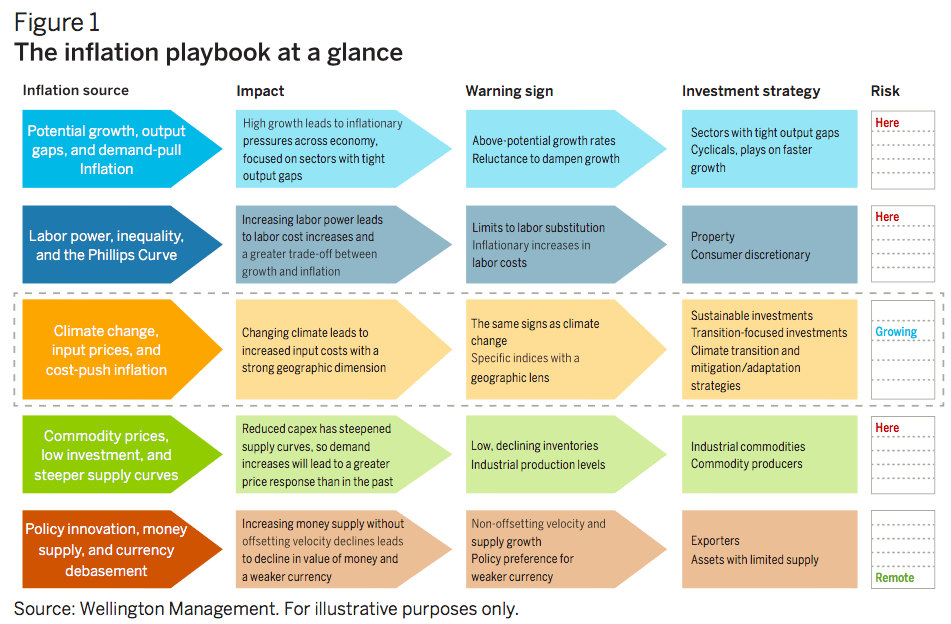By Nick Samouilhan and Joy Perry, Strategist/Portfolio Manager and Investment Director respectively at Wellington, who explore the link between climate change and inflation and suggest strategies to help mitigate the threat to client portfolios
(The views expressed are those of the authors at the time of writing. Other teams may hold different views and make different investment decisions. The value of your investment may become worth more or less than at the time of original investment. While any third-party data used is considered reliable, its accuracy is not guaranteed. For professional, institutional, or accredited investors only.)
Rapidly rising inflation is a growing concern across the world. Much attention is centred on how supply issues, labour shortages and an economic recovery outpacing potential output are driving up inflation. However, we think that focusing on these “traditional” factors alone offers investors only a partial picture as, in our view, climate risk will be an increasingly important source of inflation. Specifically, we worry about the potential for input price shocks caused by intensifying global climate change. As many investors are not fully aware of climate change as a source of inflation risk, we explore below why we think the impact of a changing climate is inflationary and suggest strategies to help reduce the threat to investment portfolios.
The relationship between climate change and inflation
- Overview: A price shock to a systemically important input price will tend to spur higher inflation as businesses pass it on to consumers, leading to “cost-push” inflation. While this has historically been due to geopolitical forces driving oil prices, we believe the impact of climate change on a range of commodities will become a bigger factor. Increased government spending and stricter regulation as part of the long-term endeavour to gradually decarbonise global economies — the “energy transition” — may also contribute to higher inflation in the period ahead. Among other reasons, carbon-free goods currently often cost more than their carbon-emitting counterparts.
- Inflationary process: Climate change inflation’s key characteristic is its distinct geographic dimension, as a given sector may experience input price inflation only in certain global locations where the local effects of climate change tend to be more acute. Food (agriculture) costs, for example, may rise sharply in some regions but fall in others. Extreme weather conditions can induce inflation through supply destruction or disruption. Climate change will likely leave few sectors unaffected by higher input prices. In addition, government-led policy initiatives and other efforts to combat climate change could intensify cost pressures.
- Warning signs: The warning signs to watch for here mirror those for climate change in general, where location-specific tracking indices can prove quite helpful. Some widely used examples are the National Weather Service Heat Index, the Palmer Drought Severity Index, the Fire Weather Index, and the World Resource Institute’s Water Scarcity Index. Anecdotally speaking, one needs to look no further than recent news feeds to find mounting evidence of global climate change. For instance, the summer of 2021 was reportedly one of the hottest ever.
- Where we are today: According to most climate experts, the risk of global climate change is growing. In fact, across a range of closely followed indicators, there are already clear signals that climate change is having a discernible impact on global macroeconomic conditions, including different forms of inflation. We view climate change as an inexorable long-term trend that will continue to present a variety of risks and opportunities for investors. Inflation and regulatory risk, fuelled in part by increased regulation and rising government and industry spending directed towards slowing the advance of global climate change, constitute critical considerations for investors.
- Mitigation and adaptation solutions: We believe a holistic approach to addressing climate change and its inflationary impact on a portfolio should incorporate both climate mitigation and climate adaptation solutions. Such solutions should ideally be based on using geography to manage the related risks and position for the potential opportunities, including rebuilding or retrofitting geographies as needed in some cases. Specific mitigation and adaptation strategies may involve investing in climate transition tools and technologies (e.g., green building, public transport, infrastructure, electric vehicles, water/waste management, renewable energy, agriculture).
For many investors, a ready-made climate transition and mitigation/adaptation strategy may be a particularly effective tool to help defend portfolios against inflation and other risks arising from climate change (Figure 1).
For more information, please visit wellingtonfunds.com
Disclaimer:
This material is not intended to constitute investment advice or an offer to sell, or the solicitation of an offer to purchase, shares or other securities. In Europe (ex. UK and Switzerland), issued by Wellington Management Europe GmbH which is authorised and regulated by the German Federal Financial Supervisory Authority (BaFin).




